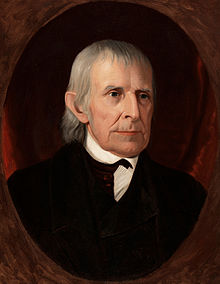Adam Eckfeldt
| Adam Eckfeldt | |
|---|---|
 |
|
| 2nd Chief Coiner of the United States Mint at Philadelphia | |
|
In office February 15, 1814 – March 15, 1839 |
|
| President | |
| Preceded by | Henry Voigt |
| Succeeded by | Franklin Peale |
| Personal details | |
| Born |
John Adam Eckfeldt June 15, 1769 Philadelphia, Pennsylvania |
| Died | February 6, 1852 (aged 82) Philadelphia, Pennsylvania |
| Nationality | American |
| Spouse(s) |
|
| Children |
|
John Adam Eckfeldt (June 15, 1769 – February 6, 1852; usually Adam Eckfeldt) was a worker and official in the early days of the United States Mint. A lifelong Philadelphian, Eckfeldt served as the second chief coiner of the Mint, from 1814 until 1839.
Eckfeldt's father owned a large smithy and involved himself in early attempts at American coinage. Adam Eckfeldt built early presses for the Mint, engraved some of its early dies, and was responsible for the designs of early American copper coinage, as well as the 1792 half disme which some authorities consider the first United States coin. He was appointed assistant coiner of the Mint in 1796, and became chief coiner on his predecessor's death in 1814.
Eckfeldt served a quarter century as chief coiner, during which time the Philadelphia Mint moved to new premises. As he set aside unusual coins brought in as bullion, he started the Mint's coin cabinet, which evolved into the National Numismatic Collection. Even after his 1839 retirement, Eckfeldt continued to perform the duties of chief coiner; his death in 1852 caused his replacement, Franklin Peale, to seek an assistant.
John Adam Eckfeldt was born in Philadelphia on June 15, 1769, the son of John Jacob Eckfeldt, a large-scale manufacturer of edge-tools and implements. At the time, it was common for those of German descent to bear the name "John" but be referred to by middle name. The elder Eckfeldt and his wife Maria Magdalena had immigrated from Nuremberg, Bavaria, around 1764. John Jacob Eckfeldt, in his large smithy, made dies for the 1783 coinage under the Articles of Confederation authorized by Philadelphia financier Robert Morris. Adam was his father's apprentice, and was skilled in iron work and machinery.
During Eckfeldt's childhood, the thirteen British colonies along the Atlantic coast of what is now the United States revolted, and so the United States of America secured its independence. After the United States Constitution was ratified, Congress and many government offices came to be housed in Philadelphia, including the newborn Mint of the United States. Adam Eckfeldt built the first screw press for the new facility in 1792, the same year that the Mint Act of 1792 was passed by Congress authorizing a mint, and cut the obverse die for the experimental Birch cent of that year. He also built other machinery for the Mint, and helped superintend the early coining.
...
Wikipedia
